Tuesday, 8 August, cruising to Mandrogy and beyond
Written 10 September 2017
Once again, we cruised all night. After breakfast, Margo conducted a briefing that covered our excursions and options in St. Petersburg, where we would arrive during the night after today's time in Mandrogy, as well as how disembarkation at the end of the cruise would work. Note that this was Tuesday, and we didn't disembark until Saturday morning, but as Karoline pointed out, we would be so busy once we got to St. Petersburg that the crew would hardly see us, and no time would be left over for briefings. That's why, on a 14-day cruise, we had our welcome dinner on day 4 and our farewell dinner on this evening, day 9. The two big cities at the ends of the tour just provided too much to see and do to leave time for ceremony.
Mandrogy (meaning "Upper Falls") is sort of the commercial version of Kizhi. It's on the Svir River between Lake Onega and Lake Ladoga and was originally a small village. It was wiped out during World War II and disappeared from the map until, in 1996, an entrepreneur got the idea to reconstruct it as a (for-profit) open-air museum to attract all the cruise ships on that route. It's got a couple of hotels and claims to have windmills, vodka and bread museums, potters, weavers, jewelers, a moose farm, a stable, an archery range, trout and carp fishing, and a small zoo of local animals.
He managed to get a number of artists and craftspeople to set up shop, and I think a few people live there—at any rate, some of the houses are marked "private."
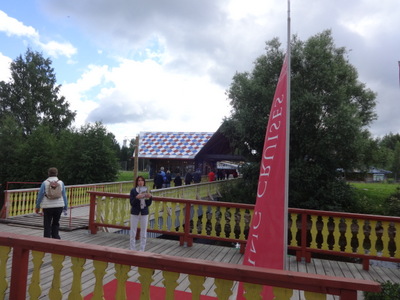
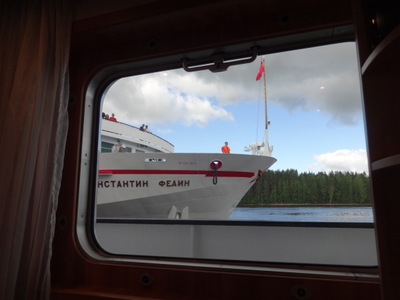 It's another popular stop for cruises, so as soon as we pulled up to the dock, about 9:30 a.m. (you can see the red "Viking" flag marking our berth), we were joined by the Konstantin Fedin, a ship of some other line. (Fedin was a Russian novelist.) In the course of the day, we encountered tourists speaking at least four languages.
It's another popular stop for cruises, so as soon as we pulled up to the dock, about 9:30 a.m. (you can see the red "Viking" flag marking our berth), we were joined by the Konstantin Fedin, a ship of some other line. (Fedin was a Russian novelist.) In the course of the day, we encountered tourists speaking at least four languages.
Only two excursions were offered in this port, both optional—a paint-your-own-matryushka-doll workshop, which we declined, and the notorious "banya," in which you steam for a while in a sauna, then get doused with cold water (some places use a hose; others just have you jump in the lake), then get beaten vigorously about the head, shoulders, and back with freshly cut birch branches collected for the purpose. We didn't just decline that one; we backed hastily away making the sign against the evil eye.
So we had the entire day at liberty. David slept in, and the rest of us set out to explore the place. Mandrogy was the port recommended for the acquisition of matryushka dolls, but none of us acquired one.

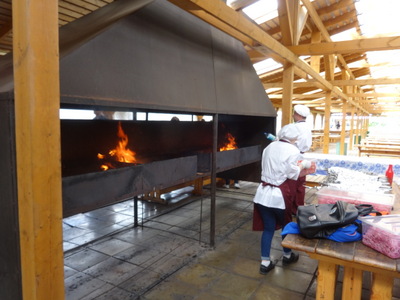 We walked right off the dock and into the thick of the "village," and the very first thing we encountered was a set of three of these vast picnic pavillions, all in the early stages of preparing to feed one whole heck of a lot of people. Here, at the left, young women are setting out trays of piroshkis (a local specialty). I assume these have a sweet filling, as they are being laid out on a a table with squares of cake with a red fruit topping. The tables are all set with wooden racks holding plastic cups, plastic cutler, paper napkins, salt and pepper, and toothpicks.
We walked right off the dock and into the thick of the "village," and the very first thing we encountered was a set of three of these vast picnic pavillions, all in the early stages of preparing to feed one whole heck of a lot of people. Here, at the left, young women are setting out trays of piroshkis (a local specialty). I assume these have a sweet filling, as they are being laid out on a a table with squares of cake with a red fruit topping. The tables are all set with wooden racks holding plastic cups, plastic cutler, paper napkins, salt and pepper, and toothpicks.
At the right are bins full of charcoal (real charcoal, not briquettes) being lit. On the table are large plastic bins of red onion rings marinating in something and a big heap of long skewers. The skewers look long enough to lie across the bins of charcoal, without benefit of grills. On other tables, other large plastic bins of red-cabbage slaw were waiting.
Written 11 September 2017 (yes, during Hurricane Irma; as long as the power stays on and the wind doesn't get too scary . . .)
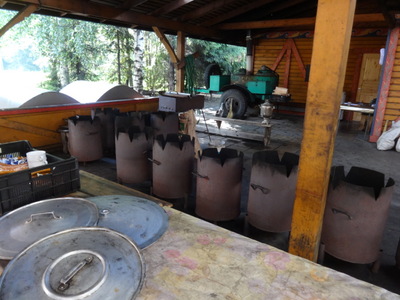
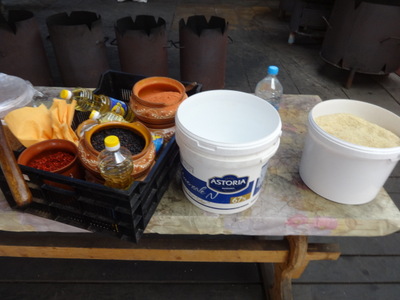 In another corner was this row of vertical burners on top of which large pots or kettles could be set. I didn't see how they were fired—probably with charcoal from the large paper bag behind them. The bright blue spot in the plastic crate of coffee cups at the left is a bowl of individual plastic cups of coffee creamer.
In another corner was this row of vertical burners on top of which large pots or kettles could be set. I didn't see how they were fired—probably with charcoal from the large paper bag behind them. The bright blue spot in the plastic crate of coffee cups at the left is a bowl of individual plastic cups of coffee creamer.
The bright teal-colored thing on wheels in the background is a military field kitchen, just like the ones I've seen in World War II museums (except that they were painted more military colors), with a fire box and chimney in the middle and deep covered kettles fore and aft. Drip pans underneath, and a little heap of firewood on a shelf in the back. In front of it, sitting on a bench, is the inevitable samovar.
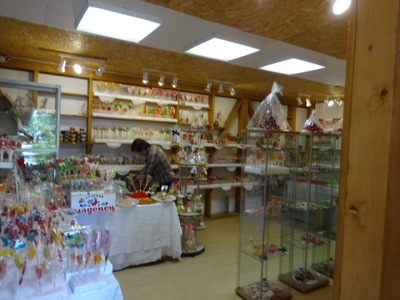
 In a wooded area behind the open space with the picnic pavillions was this building, labeled "candy shop" on the signs pointing to it but "caramellier school" on the door. As you can see from the photo, it sold all manner of candy made of cooked sugar—mostly lollipops and hard candies, plus a few fancy items like flowers made of hard candy. I saw no evidence of anything we would call caramel, a clue (I suspect) to our chef's interpretation of some recipes.
In a wooded area behind the open space with the picnic pavillions was this building, labeled "candy shop" on the signs pointing to it but "caramellier school" on the door. As you can see from the photo, it sold all manner of candy made of cooked sugar—mostly lollipops and hard candies, plus a few fancy items like flowers made of hard candy. I saw no evidence of anything we would call caramel, a clue (I suspect) to our chef's interpretation of some recipes.
More interesting was this herbalist's shop, recognizable from the bundles of drying herbs hanging from nails in the beam out front. It carried many culinary herbs, but the emphasis seemed to be on medicinal ones.
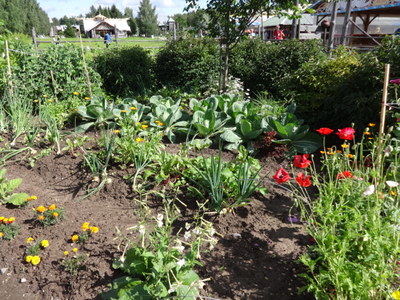
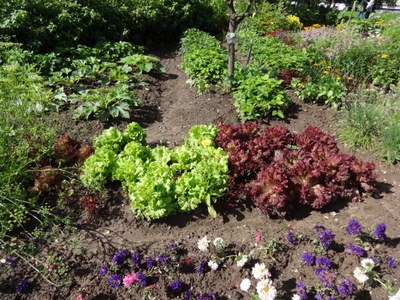 It was surrounded by a good-sized garden in which medicinal and culinary herbs and vegetables were mixed with ornamental plants. At the left here, you can see peas, onions, cabbages, beets, and a young fruit tree sharing space with marigolds, tuberoses, two colors of poppy (ornamental or medicinal, I wonder), evening primroses, and some kind of tall yellow composite.
It was surrounded by a good-sized garden in which medicinal and culinary herbs and vegetables were mixed with ornamental plants. At the left here, you can see peas, onions, cabbages, beets, and a young fruit tree sharing space with marigolds, tuberoses, two colors of poppy (ornamental or medicinal, I wonder), evening primroses, and some kind of tall yellow composite.
At the right are dill, two colors of leaf lettuce, strawberries, squash plants, and the trunk of another fruit trees, together with a variety of ornamentals. The ones in the foreground don't look as though they grew there—I think they had been recently transplanted to fill an empty spot.

 The left-hand photo here is of ripe gooseberries.
The left-hand photo here is of ripe gooseberries.
At the right are flat-leafed chives (the lavender pompoms in the front), another fruit tree, and more beets. Behind them are cornflowers and even a patch of grain.
—
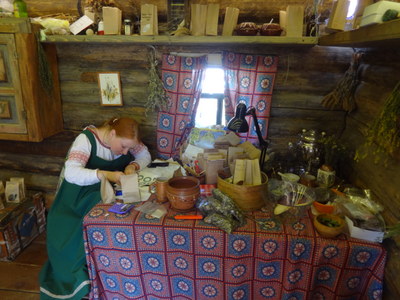
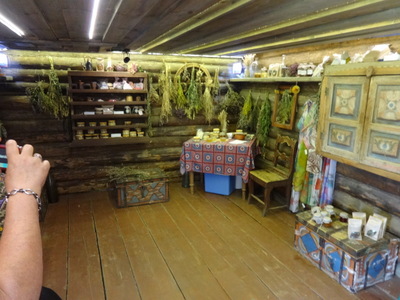 Here, indoors, is the herbalist herself, busily making up and labeling bags of her mixtures. The labels in this photo are all in Russian, and transliteration doesn't help, though the clear plastic bags next to the orange-handled knife look like chamomile. Note the samovar to the right of the desk lamp. Are all these samovars regularly used, or are they just considered an essential decorative item wherever tourists are found?
Here, indoors, is the herbalist herself, busily making up and labeling bags of her mixtures. The labels in this photo are all in Russian, and transliteration doesn't help, though the clear plastic bags next to the orange-handled knife look like chamomile. Note the samovar to the right of the desk lamp. Are all these samovars regularly used, or are they just considered an essential decorative item wherever tourists are found?
This view of the rest of the room shows some of the products for sale, which included herbs, herb mixtures, honeys and jams (herb-flavored and not), teapots, and scarves. On one shelf, I found bags of dried cloud berries (which look like yellow raspberries with just a few drupelets each) and an herb tea containing black tea, black currant leaf, rose hips, strawberry leaf, and raspberry leaf. The latter was also labeled in German—who knew that "black currant" was "Johannisbeere"?
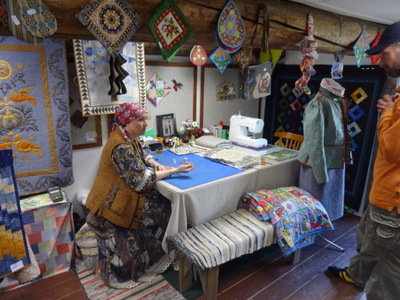
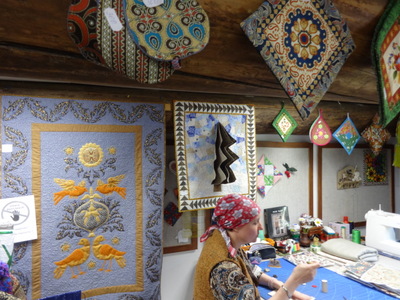 Next was a quilt shop, selling full blanket-sized quilts, pot holders, coasters, tote bags, clothing, and one little patchwork teddy bear, hanging from a beam by one arm.
Next was a quilt shop, selling full blanket-sized quilts, pot holders, coasters, tote bags, clothing, and one little patchwork teddy bear, hanging from a beam by one arm.
The quilter was sewing some small item by hand at the time, but the larger work must be machine quilted—she couldn't possibly produce that density and intricacy of quilting fast enough by hand to make any money. The jacket and skirt alone would have taken months.
The photo at the right gives a closer view of the quilt with the golden birds and the smaller one with the whimsical three-dimentional tree.

 In what seemed to be a carpentry shop (not in operation when I was there) was this huge collection of what I call "snow scooters" for lack of a better term. I haven't been able to come up with a combination of search terms that will bring up a photo of one and tell me what they really are and what they're called. These are stored with their "ski" portions tucked into grooves between the beams, except for a few with metal skis, which are too thick.
In what seemed to be a carpentry shop (not in operation when I was there) was this huge collection of what I call "snow scooters" for lack of a better term. I haven't been able to come up with a combination of search terms that will bring up a photo of one and tell me what they really are and what they're called. These are stored with their "ski" portions tucked into grooves between the beams, except for a few with metal skis, which are too thick.
The two long slanted items in the right-hand photo are flax mashers. Each of these actually has two grooves, each with its own masher; both mashers raised and lowered by the same handle. A third one is end-on to the camera at the lower right corner of the photo; there, you can see the structure of the two grooves and two mashers.
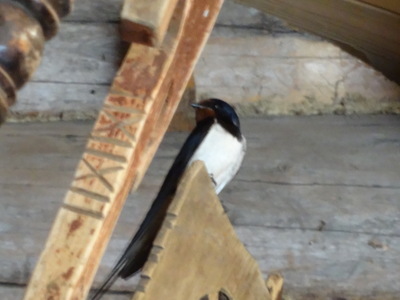
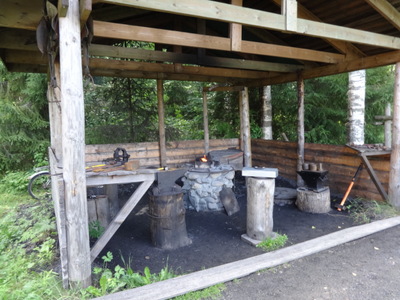 Swallows were nesting in part of the building, and I finally managed to get a decent photo of one. I think it's a barn swallow (Hirundo rustica).
Swallows were nesting in part of the building, and I finally managed to get a decent photo of one. I think it's a barn swallow (Hirundo rustica).
Back out on the path, I passed this blacksmith's shed. The forge was hot and ready to go, but no blacksmith was in evidence. I didn't wait around to see if anyone came back, as I was (as usual) due back on the ship by 12:15, and a lot remained to be seen.
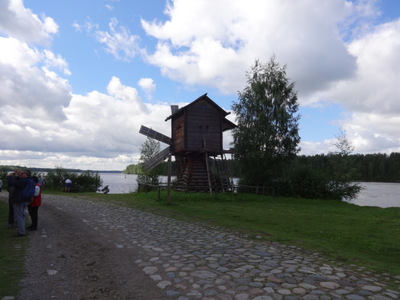
 At the left here is another of those mills designed to be turned to face the wind. Nearby a guys was busking with one of those laptop instruments that looks like a large lute with no neck that you play by turning a crank on one end, but I didn't stop to listen.
At the left here is another of those mills designed to be turned to face the wind. Nearby a guys was busking with one of those laptop instruments that looks like a large lute with no neck that you play by turning a crank on one end, but I didn't stop to listen.
I also didn't take the ferry to the "Fairy Path" and minizoo of local animals (goats, donkeys, and sheep, as well as wild species). As you can see in the right-hand photo, the ferry was rectangular and crossed a waterway that was only about four or five times its own length. It slid back and forth along a cable that ran from one landing to the other, through the small rectangular hole that you can see below the deck on the near end of the ferry. It carries 25 people and is propelled by a young man in a yellow cap (the left-most figure on the ferry) who walks around and around a capstan on the deck. I don't know whether his motion pulls the ferry along the cable or just actuates an underwater paddle wheel or some such.
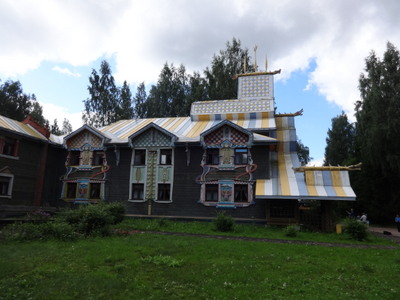
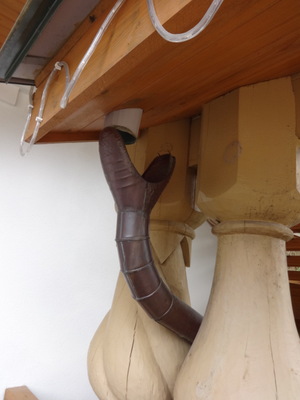 Beyond the ferry (and some houses marked "private"), was this ornate hotel, newly built but in a kind of Viking style. Note the ridgepoles ending in dragons' heads.
Beyond the ferry (and some houses marked "private"), was this ornate hotel, newly built but in a kind of Viking style. Note the ridgepoles ending in dragons' heads.
Elsewhere, this modern metal dragon gulps the outflow from a downspout. The clear plastic tube shelters twinkle lights.
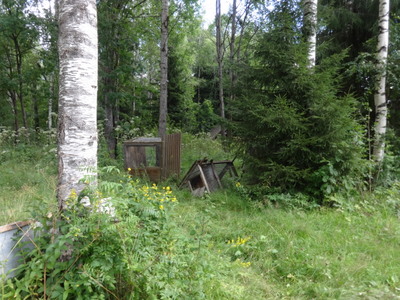
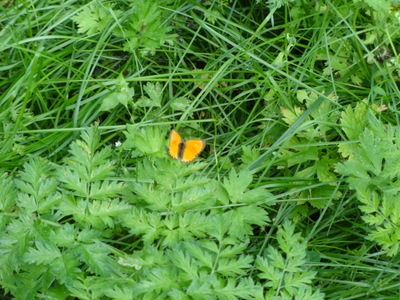 My ultimate destination, at the far end of the settlement from the boat dock, was the quail farm, but when I got there, this is what I found—a ramshackle and clearly abandoned raised coop perhaps 10 by 15 feet, hidden back in the bushes (you can see a section of its sloped, shingled roof), and a couple of overturned and broken cages. This is as close as I got, in my light shoes and bare ankles, before the path was too overgrown to proceed. Drat.
My ultimate destination, at the far end of the settlement from the boat dock, was the quail farm, but when I got there, this is what I found—a ramshackle and clearly abandoned raised coop perhaps 10 by 15 feet, hidden back in the bushes (you can see a section of its sloped, shingled roof), and a couple of overturned and broken cages. This is as close as I got, in my light shoes and bare ankles, before the path was too overgrown to proceed. Drat.
Later, I learned that Ev had independently made the same walk and was equally disappointed. He had also tried to visit the bread museum, which I had somehow overlooked on the map, only to find absolutely nothing on the designated spot.
At least I got this photo of a nice yellow butterfly. Here, I'd call it the male of one of the sulfurs, but my European insect book doesn't show anything with wings that solid color without dots or other markings except the "cuivré de la verge d'or" (the gold-edged copper, Heodes virgaureae, and it's shown as darker colored than this specimen.

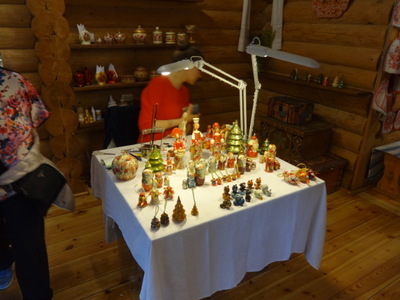 Drifting back toward the ship, I stopped briefly in a craft shop where ladies were painting matryushkas and lacquered items, especially other dolls, eggs, and Christmas trees. The photo at the left shows several layers of a matryushka with only their blue kerchiefs so far painted.
Drifting back toward the ship, I stopped briefly in a craft shop where ladies were painting matryushkas and lacquered items, especially other dolls, eggs, and Christmas trees. The photo at the left shows several layers of a matryushka with only their blue kerchiefs so far painted.
In the right-hand photo, the artist os working on a tall slender figurine of a lady in native dress.
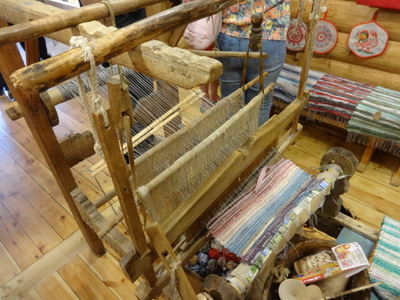
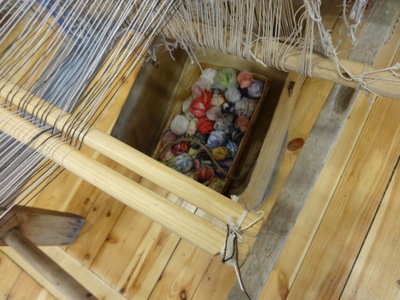
In the right-hand photo is a loom strung with a partially completed rag rug. The warp looks ordinary string, though it may be something sturdier. The weft is strips of torn cloth, nominally rags, worn-out clothes, that sort of thing. Underneath was this box full of colorful cloth strips, rolled into balls, waiting to be woven in.
Examples of the finished product are visible in some of the photos above. The quilter is sitting on one, her chair is resting on another, and a third is spread on the bench beside her table. On is visible draped over a bench in each of the photos of the craft shop (lower left of the left-hand photo, right-hand edge of the right-hand photo). An especially long one stretched across the the floor of one of the bedrooms of the house in Kizhi.
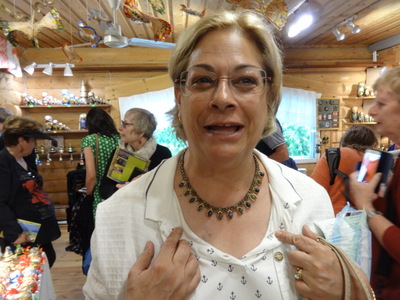

In the craft shop, I ran into Rachel, who proudly displayed a necklace she had acquired in the jewelry shop.
We were both on our way back toward the ship, and the last stop on the way, for Rachel, Ev, and me, was a piroshki shop. It smelled delicious, and this photo shows only about half of the counter spread for our inspection. Some of the flavors shown here are sausage (the cylindrical ones), cabbage, potato, meat, fish, cheese, strawberry, and blueberry. The open-faced thing is blackberry. But we'd been promised piroshkis for lunch on the ship, from this very shop, so we resisted temptation.
Written 13 September 2017
The closer we got to the ship, the more the shops pushed "souvenirs," as opposed to crafts. In addition to whatever else they were selling, they all sold chocolate and local cookies. Honey was also frequent, and I learned the the Russian word for honey is "meed," probably cognate with the English word "mead." One of my favorite offerings was a kid's t-shirt that read "I have been to Moscow; there were no bears."
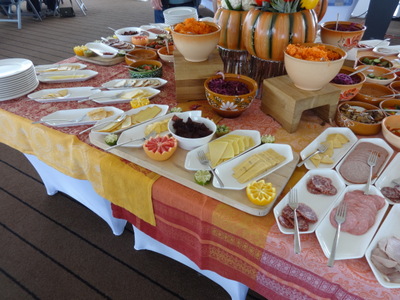
 As promised, back on the Akun a lunch buffet had been set up on the sun deck offering the large assortment of cold cuts, cheeses, herring, vegetable salads, and pickles (including picked mushrooms and peppers). The ceramic pumpkins are vases which were filled with bouquets made of cauliflower, cherry tomatoes on the vine, pineapple tops, and bell peppers carved into tulips. I was especially delighted to find slices of cold boiled tongue among the choices. The left-overs reappeared on the breakfast buffet for a couple of days.
As promised, back on the Akun a lunch buffet had been set up on the sun deck offering the large assortment of cold cuts, cheeses, herring, vegetable salads, and pickles (including picked mushrooms and peppers). The ceramic pumpkins are vases which were filled with bouquets made of cauliflower, cherry tomatoes on the vine, pineapple tops, and bell peppers carved into tulips. I was especially delighted to find slices of cold boiled tongue among the choices. The left-overs reappeared on the breakfast buffet for a couple of days.
The cold savory buffet was set up in the center of the deck. Along the starboard rail was a row of chafing dishes with hot savory items: sausage rolls, piroshkis, chicken wings, pelmeni, pilafs, etc. Along the port rail was the dessert buffet, part of which appears in the left photo, somewhat picked over. I don't know what was in the samovar, but the covered chafing dish was full of blintzes. In front of it are dishes of strawberry jam, apricot jam, and sour cream. The round buns were cheese-topped, and the tart was apple and almond.
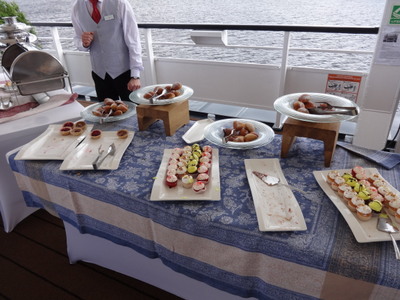
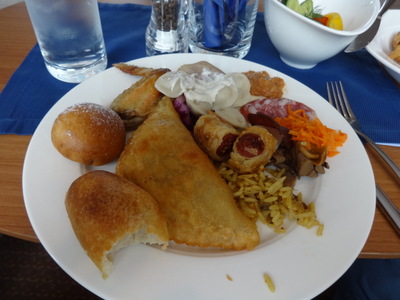 Here's more of the dessert buffet: trays of tiny cupcakes with a variety of frostings, little chocolate-filled tarts, and bowls of sugar-dusted beignets. The empty tray held spectacular round pink meringue disks topped with tall puffs of a fluffy beige-colored filling, decorated with shards of additional pink meringue, and all covered with a light coat of matching pink glaze. I didn't get one, but David did.
Here's more of the dessert buffet: trays of tiny cupcakes with a variety of frostings, little chocolate-filled tarts, and bowls of sugar-dusted beignets. The empty tray held spectacular round pink meringue disks topped with tall puffs of a fluffy beige-colored filling, decorated with shards of additional pink meringue, and all covered with a light coat of matching pink glaze. I didn't get one, but David did.
The right-hand photo shows my first plate of savory things: meat, potato, and cabbage piroshkis; a chcken wing; a sausage roll; shredded red cabbage and carrot; pickled mushrooms, and pelmeni with sour cream. In the back is a spoonful of a strange brownish relish that I never identified. On the side, a bowl of pickles
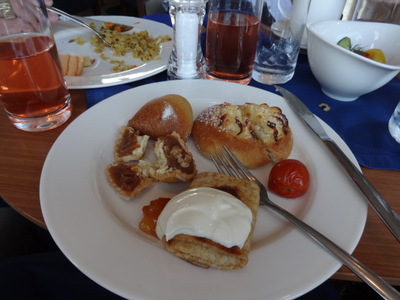
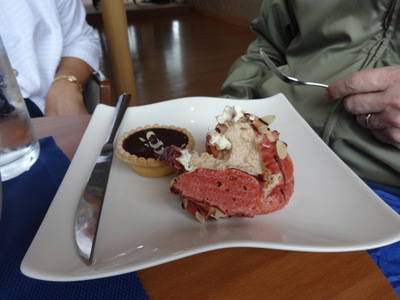 Here, at the left, is my dessert plate: a small tart, broken open to show the cheese filling and caramel-nut topping; a beignet; a cheese bun; a pickled cherry tomato (okay, not a dessert, but I missed them the last time around; and a blintz with all three toppings.
Here, at the left, is my dessert plate: a small tart, broken open to show the cheese filling and caramel-nut topping; a beignet; a cheese bun; a pickled cherry tomato (okay, not a dessert, but I missed them the last time around; and a blintz with all three toppings.
David took a chocolate tartlet and one of the big pink things, here broken open to show the fluffy filling.
After lunch, I picked up my copy of the "ship's quiz"—26 multiple-choice trivia questions about the Akun and her crew—from reception. It was due back at 6 p.m., and the results would be announced during the evening's entertainment. I skipped the 2:30 p.m. round-table discussion about modern Russia with Alexei, Sasha, and Vadim but showd up for the 4:00 p.m. tour of the galley.
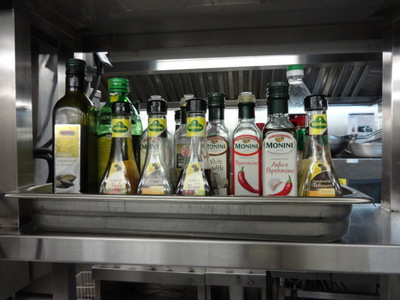
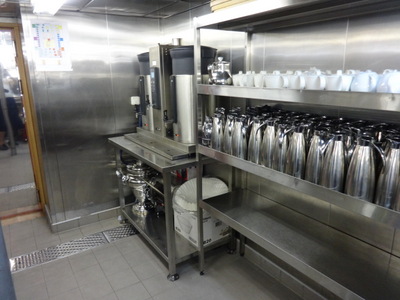 On the Portuguese cruise, we got to see the whole kitchen and meet the whole kitchen staff, because on that smaller ship, it was all in one place. On this ship, the "cooking" kitchen is downstairs, and we didn't get to see it. The tour included only the "plating" kitchen, which is on the same level as the dining room. In Portugal, the waiters carried every plate up and back down the stairs to the galley, but on the Akun, dumb waiters bring the cooked food up from below, and it is plated and garnished in the space we toured, then simply carried out to the tables by the waiters.
On the Portuguese cruise, we got to see the whole kitchen and meet the whole kitchen staff, because on that smaller ship, it was all in one place. On this ship, the "cooking" kitchen is downstairs, and we didn't get to see it. The tour included only the "plating" kitchen, which is on the same level as the dining room. In Portugal, the waiters carried every plate up and back down the stairs to the galley, but on the Akun, dumb waiters bring the cooked food up from below, and it is plated and garnished in the space we toured, then simply carried out to the tables by the waiters.
The space is a complicated shape with multiple partitions and nooks, but the bulk of it is divided by the main counter on which plates are assembled and garnished and above which hangs the rack that carries all the little order slips. I went behind that counter to take photos of the "back" part of the kitchen, and then got stuck there, unable to make my way through the crowd of onlookers back to the front part, where Leonidas was lecturing. I could hear him talking (most of the time) and see him through nooks in the order rack, but I couldn't see where he was pointing or ask any questions of my own.
Except for a couple of plates of hors d'oeuvres set out for us, this tray of oils and vinegars was the only actual food in evidence when we were there. All these bottles were set out on the salad bar during the lunch service each day.
The right-hand photo shows a wall of the back part of the kitchen arrayed with shelves of insulated coffee pitchers and white china tea pots. Beyond them are stacks and boxes of large coffee filters and two big urns for brewing coffee. On the bottom shelf at the back, of course, a samovar.

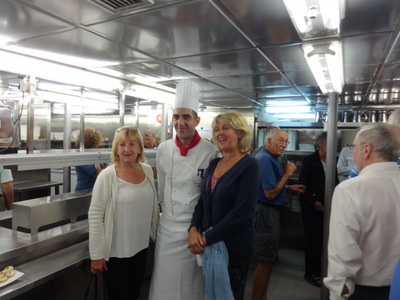 On the wall near the coffee makers was this diagram of the dining room. At the bottom, the two light-brown rectangles are the 24-hour coffee-and-cookie stations outside the dining room, flanking its entrance. The yellow sqaure in the center of the room is the service kitchen we toured, and the two rectangles above it are the buffets, one facing each side of the dining room.
On the wall near the coffee makers was this diagram of the dining room. At the bottom, the two light-brown rectangles are the 24-hour coffee-and-cookie stations outside the dining room, flanking its entrance. The yellow sqaure in the center of the room is the service kitchen we toured, and the two rectangles above it are the buffets, one facing each side of the dining room.
The tables are divided into six color-coded service stations. We always sat at table 3, 4, or 5. Those are the three light green rectangular six-tops at the lower left, so we were always in Station 1, served by Chip, Harvey, and Dasha.
Once the tour was over and the crowd thinned out a little, I got this shot of the chef with two passengers (and David's back, at the right-hand side). At the lower left, you can see our hors d'oeuvres.

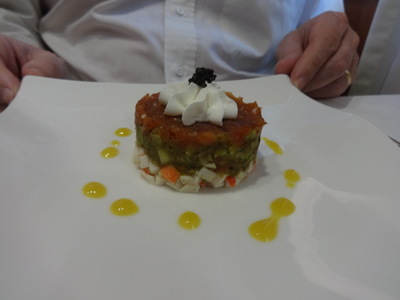 At dinner time, the captain and the senior staff assembled in the dining room for our "farewell toast," and the special "farewell dinner" was served. We each got a specially printed menu personally autographed by the captain and the manager of hotel services.
At dinner time, the captain and the senior staff assembled in the dining room for our "farewell toast," and the special "farewell dinner" was served. We each got a specially printed menu personally autographed by the captain and the manager of hotel services.
One of the three starter choices was "crisp tandoori chicken and parmesan foam with tomato asparagus salad" (talk about mixed ethnic). As you can see in the left-hand photo, the chicken was coated with panko and probably deep fried—crispy, yes, and tasty, but "tandoori"? The foam was more of a cream. The asparagus was white and had been peeled, cooked, and cut into small pieces to marinate with the tomato.
The second choice was "tuna avocado tartare with crab meat." David chose that, and it looked delicious, but of course I couldn't eat it because of the avocado. The "crabmeat" turned out to be surimi, but it was still good. Dab of black caviare on top.
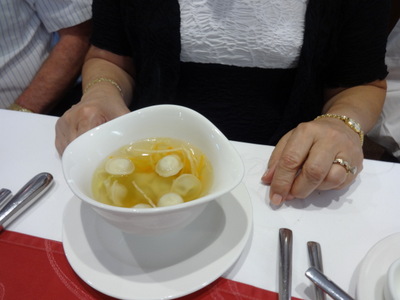
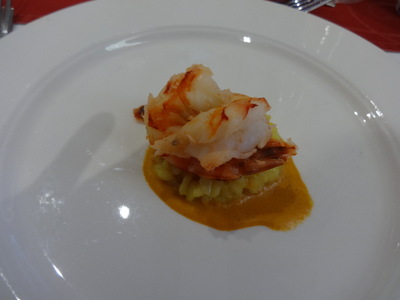 The third choice was beef consommé with aged sherry, pelmini, and vegetable julienne. Rachel ordered that. Hard to tell, but I think those pelmeni look a little hexagonal.
The third choice was beef consommé with aged sherry, pelmini, and vegetable julienne. Rachel ordered that. Hard to tell, but I think those pelmeni look a little hexagonal.
The second course, which everyone got, was "grilled scampi with saffron risotto and lobster sauce." Excellent. The sauce was a good take on the "armoricaine" sauce the French make for (and with) lobster, but the "scampi" were ordinary (very good) prawns and not true scampi.
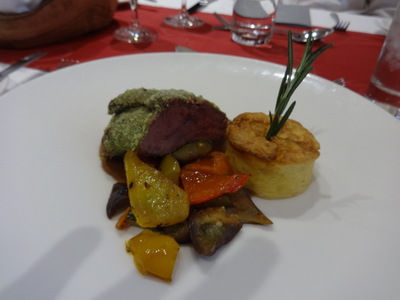
 The first of two main course choices was whole roasted beef tenderloin with truffle crust, potato soufflé, seasonal vegetables, and barolo sauce. The crust seemed to be mostly bread crumbs and something green; I couldn't taste the truffles. The potato soufflé was a neat round plug cut from a gratin of potato, and the "seasonal vegetables" were bell peppers, some pieces of which were the shape of tulip petals. (Please realize that, when I make note of things like left-over tongue on the breakfast buffet or lunchtime's decorations reused as dinnertime's hot vegetable, I am not complaining, finding fault, or making fun. I approve of such recycling very strongly; I note it as a sign of good planning and clever management on the kitchen's part.) The barolo sauce was just a good brown gravy, but it probably did have red wine in it.
The first of two main course choices was whole roasted beef tenderloin with truffle crust, potato soufflé, seasonal vegetables, and barolo sauce. The crust seemed to be mostly bread crumbs and something green; I couldn't taste the truffles. The potato soufflé was a neat round plug cut from a gratin of potato, and the "seasonal vegetables" were bell peppers, some pieces of which were the shape of tulip petals. (Please realize that, when I make note of things like left-over tongue on the breakfast buffet or lunchtime's decorations reused as dinnertime's hot vegetable, I am not complaining, finding fault, or making fun. I approve of such recycling very strongly; I note it as a sign of good planning and clever management on the kitchen's part.) The barolo sauce was just a good brown gravy, but it probably did have red wine in it.
The other main course choice was grilled fillet of Norwegian salmon with rissole potatoes, sautéed garden vegetables, and sauce hollandaise. The rissole potatoes were cubes of potato sautéed all over, and the garden vegetables were more bell peppers. I didn't taste Ev's hollandaise, but I tried it when Rachel ordered eggs benedict for breakfast later in the week, and on that occasion, it was indeed a real, hand-made hollandaise, but it was vastly underlemoned.
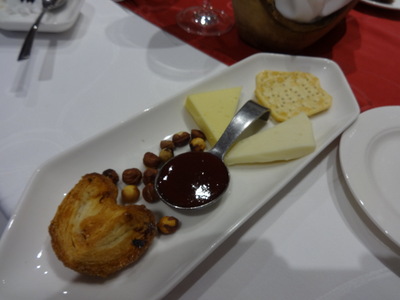
 We ordered a cheese plate for the table before dessert. The cheeses were goat cheese and Tilsiter, and again, you could only tell them apart by the color (the lighter-colored one is the goat cheese). They came with a very good strawberry-balsamic marmalade, crackers, toasted hazelnuts, and, strangely, although the menu promised a baguette, a crispy sugar-coated elephant-ear cookie.
We ordered a cheese plate for the table before dessert. The cheeses were goat cheese and Tilsiter, and again, you could only tell them apart by the color (the lighter-colored one is the goat cheese). They came with a very good strawberry-balsamic marmalade, crackers, toasted hazelnuts, and, strangely, although the menu promised a baguette, a crispy sugar-coated elephant-ear cookie.
The sole dessert was chocolate and cherry surprise with vanilla ice cream. A cylinder of chocolate-cherry ganache had been stood on end and wrapped in a sheet of chocolate, which was folded in gently over the top and dusted with cocoa. The ice cream is resting on a bed of sliced almonds (to keep the room-temperature plate from melting it), a vast improvement to my mind over the pile of cookie crumbs most restaurants use.
I had turned in my ship's quiz by the 6 p.m. deadline, so I reported to the Sky Bar at 9:30 p.m. to learn the results. I got 5 wrong, so I didn't even place in the top three. I knew the original, pre-Viking name of the Akun, the name of her captain, the shifts the officers worked, (4 hours on, 8 off), how many passengers the ship can carry, which lock we passed through twice (Rybinsk), how old Vladimir Putin is, and where Russia's first theatre troupe was established. I knew how to write "please," "thank you," and the three tour escorts' names in Cyrillic and what Margo likes best about Russia (her forests). I even got right which Viking ship Karoline is the godmother of—I knew all Viking ships are named for Norse deities, and that immediately eliminated three of the four choices. I purely guessed what shoe size tour escort Sasha wears, and got it right: 44.
But asked where the largest statue in Russia is located, I said Moscow, on the theory that it must be that gigantic sailing ship with Peter I aboard, but no, there's apparently a larger one in Volgograd. I new perfectly well that Viking has four ships in Russia this year, but I had a think-o and marked 5 instead. I didn't know how many locks we passed through (most of them were in the middle of the night, so I hadn't counted). I guessed 18, but it was 17. The 18 was a trick answer, to catch people who counted Rybinski twice. We'd been told, on different occasions, variously that Russia had 9 and 11 time zones. At the time, I'd looked up the time in St. Petersburg and that in Kamchatka and concluded that 9 was the correct answer, but no, they've recently added a couple, so the answer is 11. I guessed that they had six staff members on the reception guest (2 each on three 8-hour shifts), but the answer was four: three all day and one all night.
Finally, Rachel, Ev, and I stayed for the evening's game, called "Life Lines." It consisted of 15 multiple-choice questions of increasing difficulty and increasing numbers of choices. If you missed three questions, you were out of the competition. We made it most of the way but got four wrong. I don't remember what the questions were; all I have is our score sheet. Ev and Rachel, do you remember any of the questions?
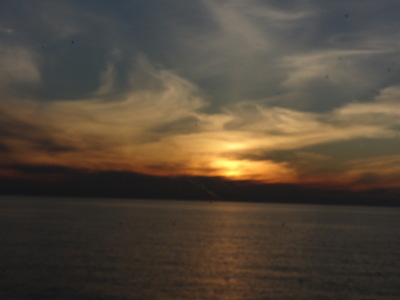 By then, it was late, so I skipped the music with Sigmund and Elena. Here, as is fitting for the night of our farewell dinner, is the obligatory sunset shot.
By then, it was late, so I skipped the music with Sigmund and Elena. Here, as is fitting for the night of our farewell dinner, is the obligatory sunset shot.
Previous entry
List of Entries
Next entry

 It's another popular stop for cruises, so as soon as we pulled up to the dock, about 9:30 a.m. (you can see the red "Viking" flag marking our berth), we were joined by the Konstantin Fedin, a ship of some other line. (Fedin was a Russian novelist.) In the course of the day, we encountered tourists speaking at least four languages.
It's another popular stop for cruises, so as soon as we pulled up to the dock, about 9:30 a.m. (you can see the red "Viking" flag marking our berth), we were joined by the Konstantin Fedin, a ship of some other line. (Fedin was a Russian novelist.) In the course of the day, we encountered tourists speaking at least four languages.
 We walked right off the dock and into the thick of the "village," and the very first thing we encountered was a set of three of these vast picnic pavillions, all in the early stages of preparing to feed one whole heck of a lot of people. Here, at the left, young women are setting out trays of piroshkis (a local specialty). I assume these have a sweet filling, as they are being laid out on a a table with squares of cake with a red fruit topping. The tables are all set with wooden racks holding plastic cups, plastic cutler, paper napkins, salt and pepper, and toothpicks.
We walked right off the dock and into the thick of the "village," and the very first thing we encountered was a set of three of these vast picnic pavillions, all in the early stages of preparing to feed one whole heck of a lot of people. Here, at the left, young women are setting out trays of piroshkis (a local specialty). I assume these have a sweet filling, as they are being laid out on a a table with squares of cake with a red fruit topping. The tables are all set with wooden racks holding plastic cups, plastic cutler, paper napkins, salt and pepper, and toothpicks.
 In another corner was this row of vertical burners on top of which large pots or kettles could be set. I didn't see how they were fired—probably with charcoal from the large paper bag behind them. The bright blue spot in the plastic crate of coffee cups at the left is a bowl of individual plastic cups of coffee creamer.
In another corner was this row of vertical burners on top of which large pots or kettles could be set. I didn't see how they were fired—probably with charcoal from the large paper bag behind them. The bright blue spot in the plastic crate of coffee cups at the left is a bowl of individual plastic cups of coffee creamer. 
 In a wooded area behind the open space with the picnic pavillions was this building, labeled "candy shop" on the signs pointing to it but "caramellier school" on the door. As you can see from the photo, it sold all manner of candy made of cooked sugar—mostly lollipops and hard candies, plus a few fancy items like flowers made of hard candy. I saw no evidence of anything we would call caramel, a clue (I suspect) to our chef's interpretation of some recipes.
In a wooded area behind the open space with the picnic pavillions was this building, labeled "candy shop" on the signs pointing to it but "caramellier school" on the door. As you can see from the photo, it sold all manner of candy made of cooked sugar—mostly lollipops and hard candies, plus a few fancy items like flowers made of hard candy. I saw no evidence of anything we would call caramel, a clue (I suspect) to our chef's interpretation of some recipes.
 It was surrounded by a good-sized garden in which medicinal and culinary herbs and vegetables were mixed with ornamental plants. At the left here, you can see peas, onions, cabbages, beets, and a young fruit tree sharing space with marigolds, tuberoses, two colors of poppy (ornamental or medicinal, I wonder), evening primroses, and some kind of tall yellow composite.
It was surrounded by a good-sized garden in which medicinal and culinary herbs and vegetables were mixed with ornamental plants. At the left here, you can see peas, onions, cabbages, beets, and a young fruit tree sharing space with marigolds, tuberoses, two colors of poppy (ornamental or medicinal, I wonder), evening primroses, and some kind of tall yellow composite.
 The left-hand photo here is of ripe gooseberries.
The left-hand photo here is of ripe gooseberries. 
 Here, indoors, is the herbalist herself, busily making up and labeling bags of her mixtures. The labels in this photo are all in Russian, and transliteration doesn't help, though the clear plastic bags next to the orange-handled knife look like chamomile. Note the samovar to the right of the desk lamp. Are all these samovars regularly used, or are they just considered an essential decorative item wherever tourists are found?
Here, indoors, is the herbalist herself, busily making up and labeling bags of her mixtures. The labels in this photo are all in Russian, and transliteration doesn't help, though the clear plastic bags next to the orange-handled knife look like chamomile. Note the samovar to the right of the desk lamp. Are all these samovars regularly used, or are they just considered an essential decorative item wherever tourists are found?
 Next was a quilt shop, selling full blanket-sized quilts, pot holders, coasters, tote bags, clothing, and one little patchwork teddy bear, hanging from a beam by one arm.
Next was a quilt shop, selling full blanket-sized quilts, pot holders, coasters, tote bags, clothing, and one little patchwork teddy bear, hanging from a beam by one arm.
 In what seemed to be a carpentry shop (not in operation when I was there) was this huge collection of what I call "snow scooters" for lack of a better term. I haven't been able to come up with a combination of search terms that will bring up a photo of one and tell me what they really are and what they're called. These are stored with their "ski" portions tucked into grooves between the beams, except for a few with metal skis, which are too thick.
In what seemed to be a carpentry shop (not in operation when I was there) was this huge collection of what I call "snow scooters" for lack of a better term. I haven't been able to come up with a combination of search terms that will bring up a photo of one and tell me what they really are and what they're called. These are stored with their "ski" portions tucked into grooves between the beams, except for a few with metal skis, which are too thick.
 Swallows were nesting in part of the building, and I finally managed to get a decent photo of one. I think it's a barn swallow (Hirundo rustica).
Swallows were nesting in part of the building, and I finally managed to get a decent photo of one. I think it's a barn swallow (Hirundo rustica).
 At the left here is another of those mills designed to be turned to face the wind. Nearby a guys was busking with one of those laptop instruments that looks like a large lute with no neck that you play by turning a crank on one end, but I didn't stop to listen.
At the left here is another of those mills designed to be turned to face the wind. Nearby a guys was busking with one of those laptop instruments that looks like a large lute with no neck that you play by turning a crank on one end, but I didn't stop to listen.
 Beyond the ferry (and some houses marked "private"), was this ornate hotel, newly built but in a kind of Viking style. Note the ridgepoles ending in dragons' heads.
Beyond the ferry (and some houses marked "private"), was this ornate hotel, newly built but in a kind of Viking style. Note the ridgepoles ending in dragons' heads. 
 My ultimate destination, at the far end of the settlement from the boat dock, was the quail farm, but when I got there, this is what I found—a ramshackle and clearly abandoned raised coop perhaps 10 by 15 feet, hidden back in the bushes (you can see a section of its sloped, shingled roof), and a couple of overturned and broken cages. This is as close as I got, in my light shoes and bare ankles, before the path was too overgrown to proceed. Drat.
My ultimate destination, at the far end of the settlement from the boat dock, was the quail farm, but when I got there, this is what I found—a ramshackle and clearly abandoned raised coop perhaps 10 by 15 feet, hidden back in the bushes (you can see a section of its sloped, shingled roof), and a couple of overturned and broken cages. This is as close as I got, in my light shoes and bare ankles, before the path was too overgrown to proceed. Drat.
 Drifting back toward the ship, I stopped briefly in a craft shop where ladies were painting matryushkas and lacquered items, especially other dolls, eggs, and Christmas trees. The photo at the left shows several layers of a matryushka with only their blue kerchiefs so far painted.
Drifting back toward the ship, I stopped briefly in a craft shop where ladies were painting matryushkas and lacquered items, especially other dolls, eggs, and Christmas trees. The photo at the left shows several layers of a matryushka with only their blue kerchiefs so far painted.




 As promised, back on the Akun a lunch buffet had been set up on the sun deck offering the large assortment of cold cuts, cheeses, herring, vegetable salads, and pickles (including picked mushrooms and peppers). The ceramic pumpkins are vases which were filled with bouquets made of cauliflower, cherry tomatoes on the vine, pineapple tops, and bell peppers carved into tulips. I was especially delighted to find slices of cold boiled tongue among the choices. The left-overs reappeared on the breakfast buffet for a couple of days.
As promised, back on the Akun a lunch buffet had been set up on the sun deck offering the large assortment of cold cuts, cheeses, herring, vegetable salads, and pickles (including picked mushrooms and peppers). The ceramic pumpkins are vases which were filled with bouquets made of cauliflower, cherry tomatoes on the vine, pineapple tops, and bell peppers carved into tulips. I was especially delighted to find slices of cold boiled tongue among the choices. The left-overs reappeared on the breakfast buffet for a couple of days.
 Here's more of the dessert buffet: trays of tiny cupcakes with a variety of frostings, little chocolate-filled tarts, and bowls of sugar-dusted beignets. The empty tray held spectacular round pink meringue disks topped with tall puffs of a fluffy beige-colored filling, decorated with shards of additional pink meringue, and all covered with a light coat of matching pink glaze. I didn't get one, but David did.
Here's more of the dessert buffet: trays of tiny cupcakes with a variety of frostings, little chocolate-filled tarts, and bowls of sugar-dusted beignets. The empty tray held spectacular round pink meringue disks topped with tall puffs of a fluffy beige-colored filling, decorated with shards of additional pink meringue, and all covered with a light coat of matching pink glaze. I didn't get one, but David did.
 Here, at the left, is my dessert plate: a small tart, broken open to show the cheese filling and caramel-nut topping; a beignet; a cheese bun; a pickled cherry tomato (okay, not a dessert, but I missed them the last time around; and a blintz with all three toppings.
Here, at the left, is my dessert plate: a small tart, broken open to show the cheese filling and caramel-nut topping; a beignet; a cheese bun; a pickled cherry tomato (okay, not a dessert, but I missed them the last time around; and a blintz with all three toppings. 
 On the Portuguese cruise, we got to see the whole kitchen and meet the whole kitchen staff, because on that smaller ship, it was all in one place. On this ship, the "cooking" kitchen is downstairs, and we didn't get to see it. The tour included only the "plating" kitchen, which is on the same level as the dining room. In Portugal, the waiters carried every plate up and back down the stairs to the galley, but on the Akun, dumb waiters bring the cooked food up from below, and it is plated and garnished in the space we toured, then simply carried out to the tables by the waiters.
On the Portuguese cruise, we got to see the whole kitchen and meet the whole kitchen staff, because on that smaller ship, it was all in one place. On this ship, the "cooking" kitchen is downstairs, and we didn't get to see it. The tour included only the "plating" kitchen, which is on the same level as the dining room. In Portugal, the waiters carried every plate up and back down the stairs to the galley, but on the Akun, dumb waiters bring the cooked food up from below, and it is plated and garnished in the space we toured, then simply carried out to the tables by the waiters.
 On the wall near the coffee makers was this diagram of the dining room. At the bottom, the two light-brown rectangles are the 24-hour coffee-and-cookie stations outside the dining room, flanking its entrance. The yellow sqaure in the center of the room is the service kitchen we toured, and the two rectangles above it are the buffets, one facing each side of the dining room.
On the wall near the coffee makers was this diagram of the dining room. At the bottom, the two light-brown rectangles are the 24-hour coffee-and-cookie stations outside the dining room, flanking its entrance. The yellow sqaure in the center of the room is the service kitchen we toured, and the two rectangles above it are the buffets, one facing each side of the dining room.  At dinner time, the captain and the senior staff assembled in the dining room for our "farewell toast," and the special "farewell dinner" was served. We each got a specially printed menu personally autographed by the captain and the manager of hotel services.
At dinner time, the captain and the senior staff assembled in the dining room for our "farewell toast," and the special "farewell dinner" was served. We each got a specially printed menu personally autographed by the captain and the manager of hotel services.
 The third choice was beef consommé with aged sherry, pelmini, and vegetable julienne. Rachel ordered that. Hard to tell, but I think those pelmeni look a little hexagonal.
The third choice was beef consommé with aged sherry, pelmini, and vegetable julienne. Rachel ordered that. Hard to tell, but I think those pelmeni look a little hexagonal.
 The first of two main course choices was whole roasted beef tenderloin with truffle crust, potato soufflé, seasonal vegetables, and barolo sauce. The crust seemed to be mostly bread crumbs and something green; I couldn't taste the truffles. The potato soufflé was a neat round plug cut from a gratin of potato, and the "seasonal vegetables" were bell peppers, some pieces of which were the shape of tulip petals. (Please realize that, when I make note of things like left-over tongue on the breakfast buffet or lunchtime's decorations reused as dinnertime's hot vegetable, I am not complaining, finding fault, or making fun. I approve of such recycling very strongly; I note it as a sign of good planning and clever management on the kitchen's part.) The barolo sauce was just a good brown gravy, but it probably did have red wine in it.
The first of two main course choices was whole roasted beef tenderloin with truffle crust, potato soufflé, seasonal vegetables, and barolo sauce. The crust seemed to be mostly bread crumbs and something green; I couldn't taste the truffles. The potato soufflé was a neat round plug cut from a gratin of potato, and the "seasonal vegetables" were bell peppers, some pieces of which were the shape of tulip petals. (Please realize that, when I make note of things like left-over tongue on the breakfast buffet or lunchtime's decorations reused as dinnertime's hot vegetable, I am not complaining, finding fault, or making fun. I approve of such recycling very strongly; I note it as a sign of good planning and clever management on the kitchen's part.) The barolo sauce was just a good brown gravy, but it probably did have red wine in it.
 We ordered a cheese plate for the table before dessert. The cheeses were goat cheese and Tilsiter, and again, you could only tell them apart by the color (the lighter-colored one is the goat cheese). They came with a very good strawberry-balsamic marmalade, crackers, toasted hazelnuts, and, strangely, although the menu promised a baguette, a crispy sugar-coated elephant-ear cookie.
We ordered a cheese plate for the table before dessert. The cheeses were goat cheese and Tilsiter, and again, you could only tell them apart by the color (the lighter-colored one is the goat cheese). They came with a very good strawberry-balsamic marmalade, crackers, toasted hazelnuts, and, strangely, although the menu promised a baguette, a crispy sugar-coated elephant-ear cookie. By then, it was late, so I skipped the music with Sigmund and Elena. Here, as is fitting for the night of our farewell dinner, is the obligatory sunset shot.
By then, it was late, so I skipped the music with Sigmund and Elena. Here, as is fitting for the night of our farewell dinner, is the obligatory sunset shot.